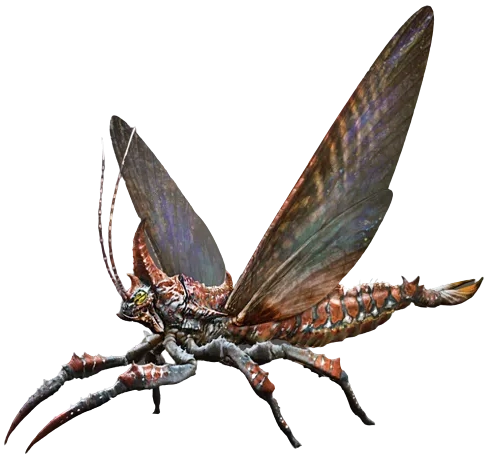Rhyniognatha Entity ID
Spawn Command
The spawn command for Rhyniognatha is below.
Blueprint Path
The blueprint path for Rhyniognatha is below.
Dossier
Wild
I swear, every new creature I come across here makes me more sure they've all had their genes tampered with. I know I'm right about this. Take this monster bug I'm calling 'Rhyniognatha antiquagenitor' -- big enough to headline a horror flick, but still light enough to fly and skate across water. Would you believe it also makes a weirdly useful, quick-hardening resin with a variety of uses? It can thicken up its shell for a defensive boost, spray hard bullet-like globs, or squirt soft globs that harden on impact to gum up incoming predators!
Domesticated
These overgrown earwigs are just what you need to level up your tribe's aerial defenses! And here's a tip: if you crush up the right Arthropleura, you'll get an enzyme that makes Rhyniognatha glue as TEK-disruptive as Dinopithecus dung. Plus this bug can glue itself to creatures or cargo and carry things around your base! That said, Rhyniognatha-raising isn't for the squeamish... Their males have a pheromone that invites egg-laying females to use them as hosts. Harvest that pheromone, and you can mark any creature for the female to lay her eggs on. The host then incubates a new generation of larvae that can reap its best traits in the process. If some poor beast gets eggs laid on it by accident, you might still be able to save it by popping it in a cryopod and freezing out the larvae.
Real World Creature Description
Rhyniognatha: A Glimpse into the Origins of Insect Evolution
In the grand tapestry of life's evolution, the majority of species that have ever existed are long extinct and known to us only through fossil evidence. Sometimes, these fossils provide vital clues about the evolutionary history of life on Earth. One such pivotal fossil is Rhyniognatha, whose discovery has ignited conversations and reevaluations of early insect evolution.
Discovery and Importance
Rhyniognatha hirsti is an extinct species of insect, known only from a fragmentary fossil. Found in the Rhynie chert in Scotland, a deposit renowned for its exquisite preservation of early land plants and arthropods, Rhyniognatha's jaws (or mandibles) are what sets it apart from other finds.
These mandibles, intricate and highly derived, suggest advanced chewing mechanisms not seen in other contemporary arthropods. Because of these specialized mouthparts, scientists believe Rhyniognatha might represent one of the earliest known insects.
Dating the Fossil
Dated to around 400 million years ago, during the Early Devonian period, Rhyniognatha provides a significant glimpse into the timeline of insect evolution. Prior to its discovery, the oldest confirmed insect fossils were from the Late Devonian, roughly 385 million years ago. Rhyniognatha pushes this timeline back by nearly 15 million years.
Inferences and Implications
The sophisticated structure of Rhyniognatha's mandibles suggests that even at this early point in time, insects had begun to diversify significantly. Some scientists even believe that if Rhyniognatha had such advanced features, winged insects might have also existed at the same time, though conclusive evidence for this remains elusive.
Rhyniognatha's existence has broad implications for understanding the evolution of early terrestrial ecosystems. Insects play a vital role in these systems, influencing plant evolution and ecological dynamics. Rhyniognatha's early appearance on the evolutionary stage could suggest that insects began impacting terrestrial ecosystems earlier than previously thought.
Challenges and Criticisms
The fragmentary nature of the Rhyniognatha fossil has led to some debate regarding its interpretation. Without a more complete specimen, certain aspects of its biology and its exact position within the insect lineage remain speculative.
Conclusion
The world of paleontology is full of surprises, with each new discovery shedding light on the intricate puzzle of life's history. Rhyniognatha stands as a testament to the value of even the smallest and seemingly inconspicuous fossils. Through its ancient jaws, it whispers tales of a world where insects began their long journey of evolution, setting the stage for the immense diversity we witness today.
Information

| Name | Rhyniognatha |
| Diet | Omnivore |
| Temperament | Aggressive |
| Rideable | |
| Saddle level | 90 |
| Category | Invertebrates |
| DLC | Base |
